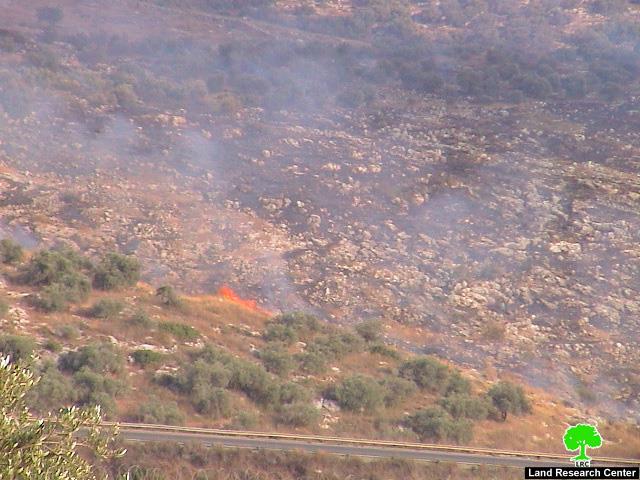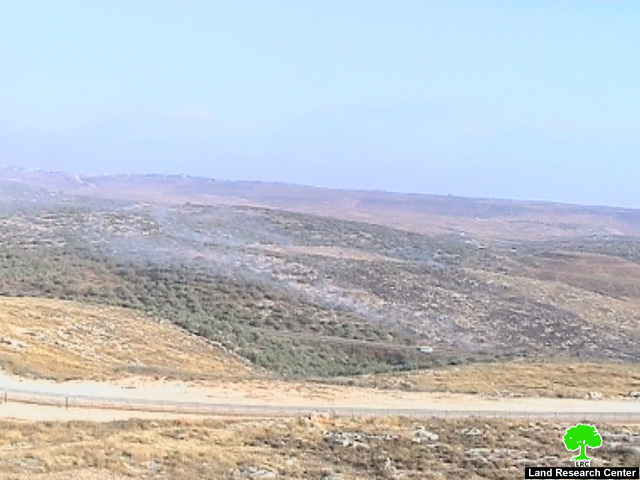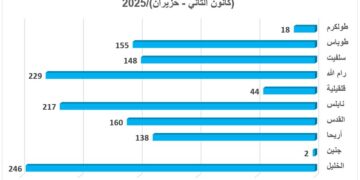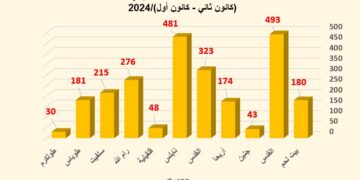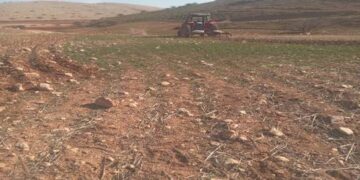(Photo 1: Fires eating the land of Far'un-Tulkarem)
Israeli settlers continue their arson attacks against the Wall- separated agricultural land of Far'un village, Tulkarem governorate. The latest arson took place on June 16, 2007, in which 162 dunums of fertile olive orchards were completely destroyed. The attacked land is located to the west of the village in basins number 8474, 8046 and 8471 which are all situated inside the Wall to the west of the agricultural Wall gate number 708 which has been closed for Palestinians since several months. When the arson was taking place the Israeli soldiers refused to open the gate for the Palestinian fire squads for three hours until the damage was done. At the same time, land owners and farmers were, also, turned back from the same gate forcing them to go to Jubara gate number 753 which is at the distances of 5 km from the scene of fire.
(Photo 2 & 3: Fires destroying olive trees in Far'un-Tulkarem)
The Palestinian land owners and farmers hold the Israeli occupation authority responsible for the continuous attacks against their lands and consider these attacks as a direct impact of the construction of the Wall and the separation of the land behind it. Additionally, they accuse the occupation army of collaborating with arson initiators by blocking the Palestinian access to the scene of the blaze when it was on.
Previous similar attacks
Two previous arson attacks were carried out by Israeli settlers against the lands of Far'un as followed:
1. In August 2006, dozens of dunums of olive tree fields located to the west and south west of the village were set on fire. However, soldiers manning the gate number 708 prevented the village citizens from accessing the area to extinguish the fire leading to the total destruction of hundreds of fruitful olive trees;
2. At the beginning of June this year, another 239 dunums of the village's south west agricultural land were put on fire. The land, which is onwed by 9 persons from the village are located in the following basins: 8466; 8470; 8472; 8473. On that occasion as well, neither local citizens nor fire brigades were allowed access to the scene of fire.
(Photo 4: The target land of Far'un can be seen behind the Wall path)
Location, population and area
The stricken border village of Far'un is located 3 km to the south of the city of Tulkarem. It has the total area of 4332 dunums, half of it was taken by the Wall (either destroyed under its path or separated behind it).(Source-Field work and GIS Unit at LRC). Far'un village's population mounts to 3591 (Source-PCBS).
After the construction of the Wall more than 400 farmers from the village whose agricultural production represents about 40% of the village's general income were deprived of their only sources of livelihood as a result of the isolation of their lands behind the Wall.
Status of agricultural Wall gate in Far'un
There is only one Wall agricultural gate to the west of Far'un village which carries the number of 708. This gate is opened only on certain seasons during the year such as the olive harvesting season. For this reason, the farmers of Far'un are obliged to use gate number 753 which belongs to Khirbet Jubara south of Far'un at the distance of 6 km from Far'un.
(Map 1: location of Far'un village)
On the other hand, the Israeli occupation authorities impose many complications on Palestinian farmers trying to get permissions to enter their separated lands. Such complications include, among others, bringing of land registration forms every six months from the Israeli land registration authorities in the colony of Kadummim and inheritance designation document and security clearance from the Israeli intelligence.
(Photo 5: Palestinian fire brigades at the scene of fire in far'un )
The people of Far'un are afraid that if the Israeli arson attacks are continued against there land there will be no need to apply for land entry permission as their land then will be reduced to nothing once it has been totally burned.
(Photo 6 & 7: The olive fields of Far'in in ablaze)
Prepared by
The Land Research Center
LRC


